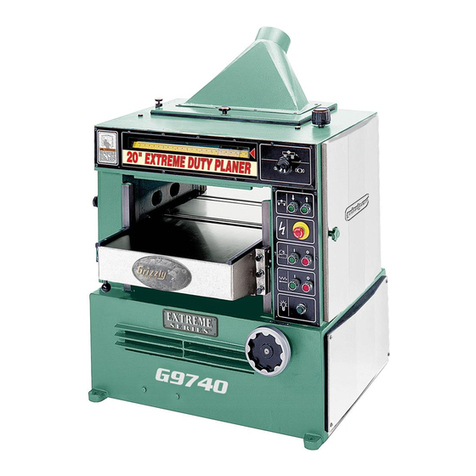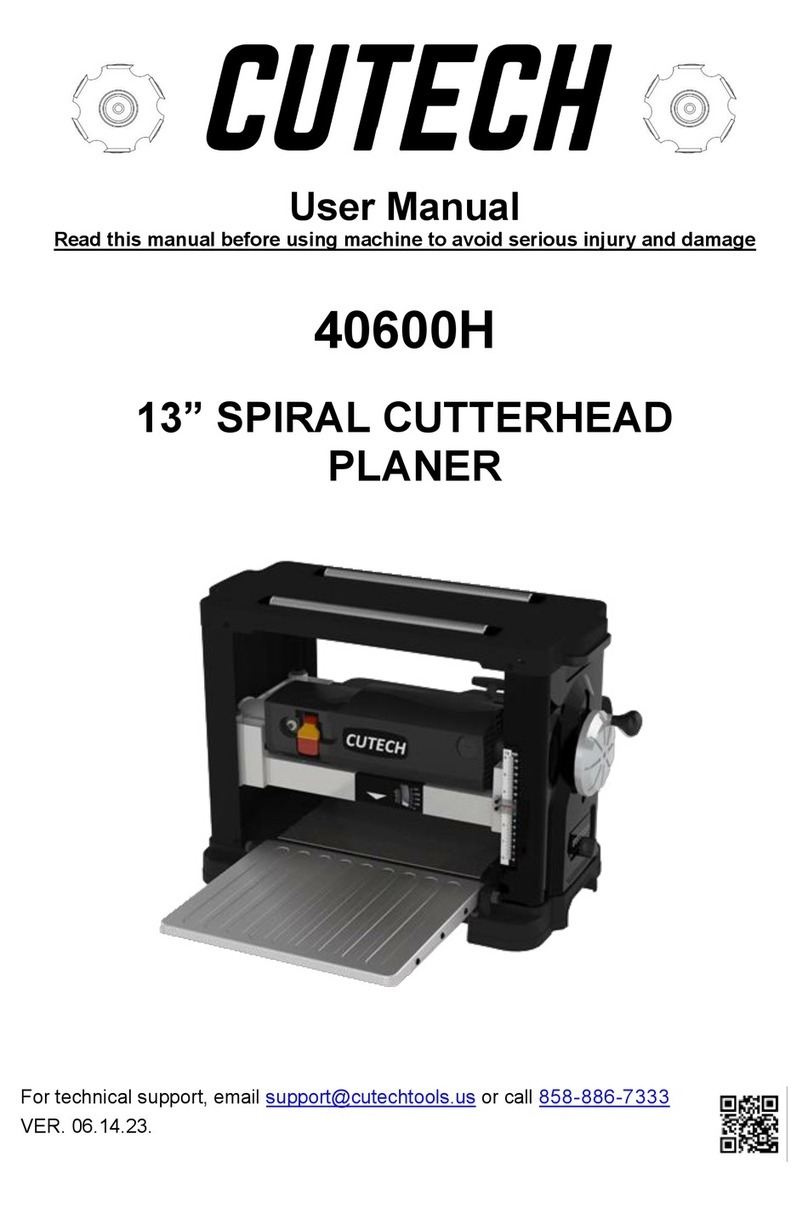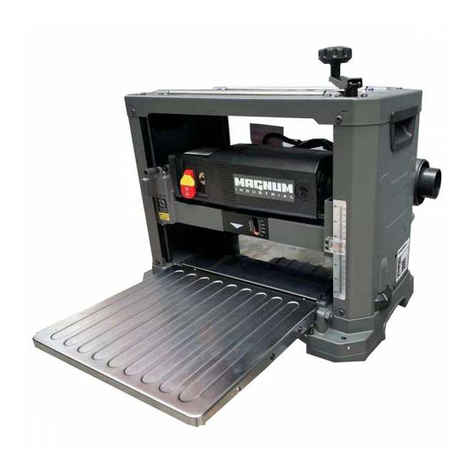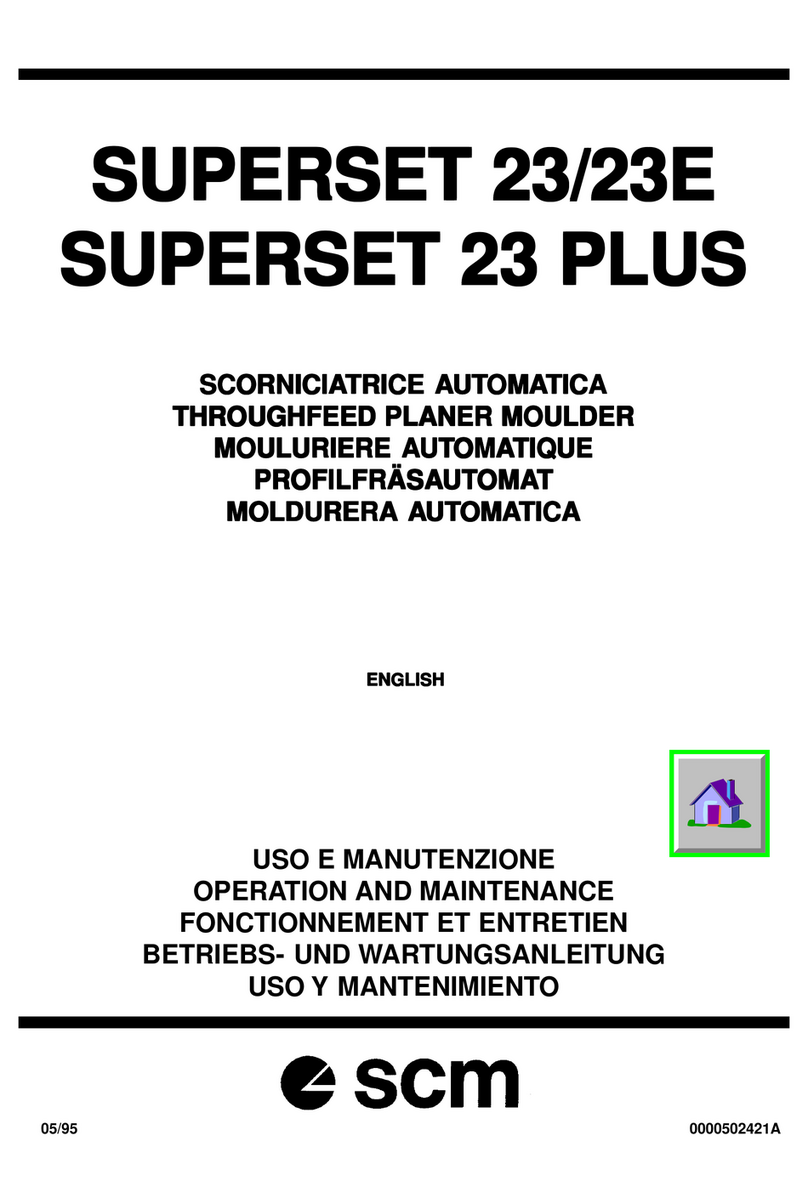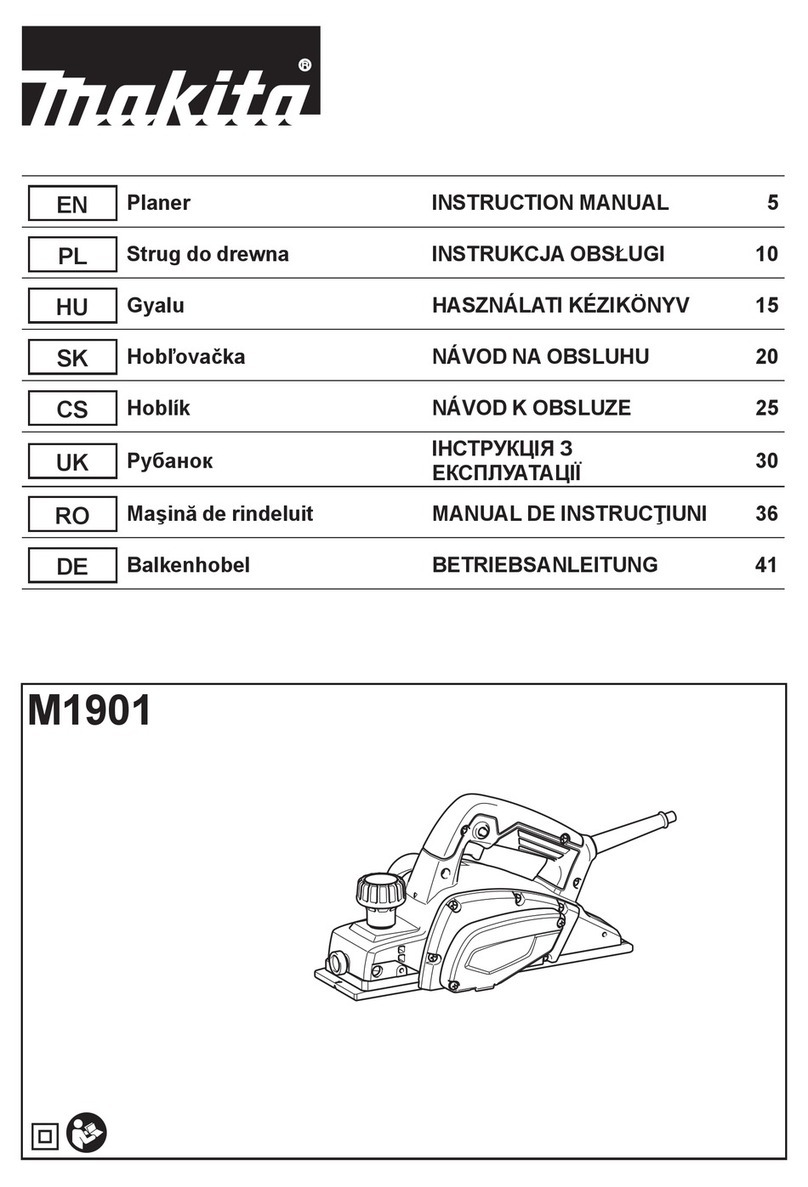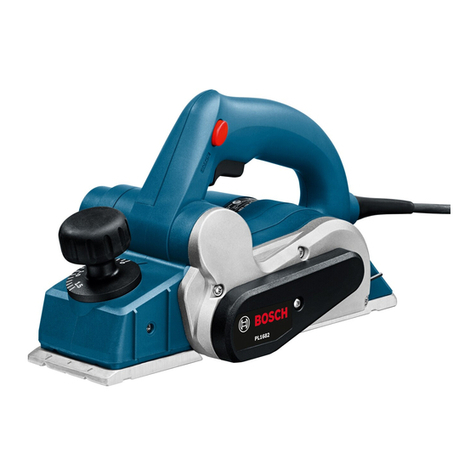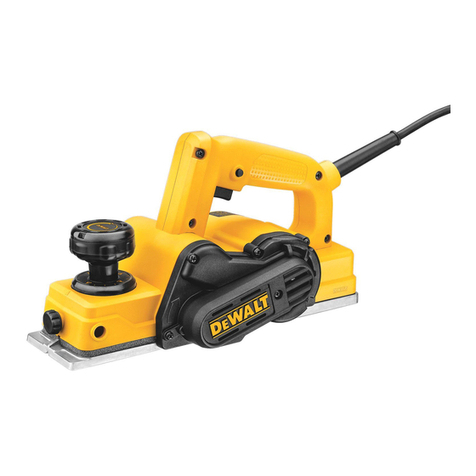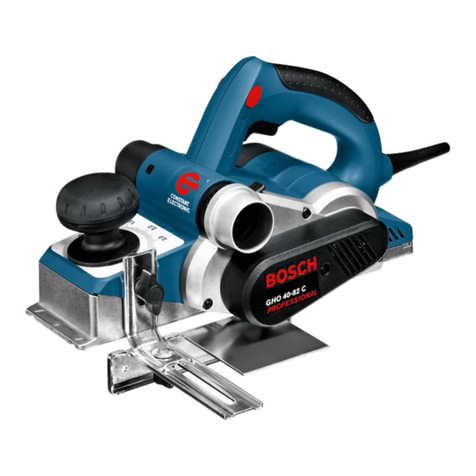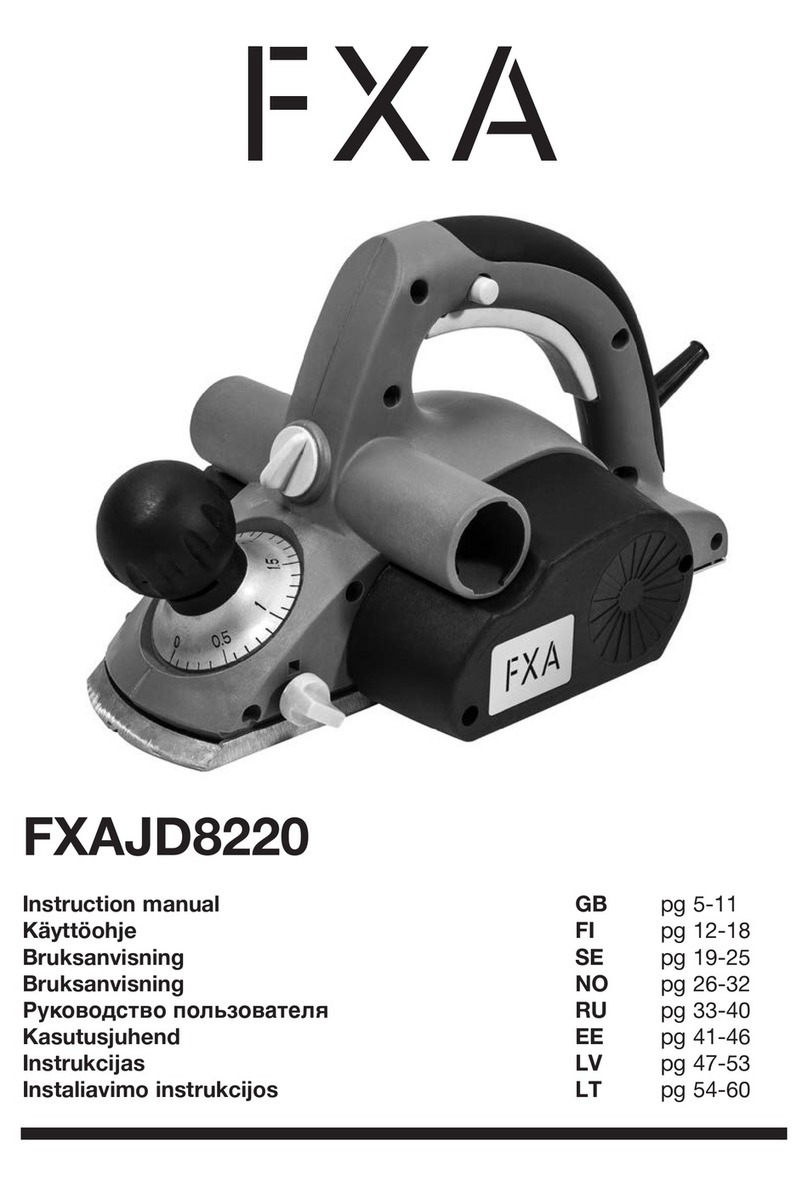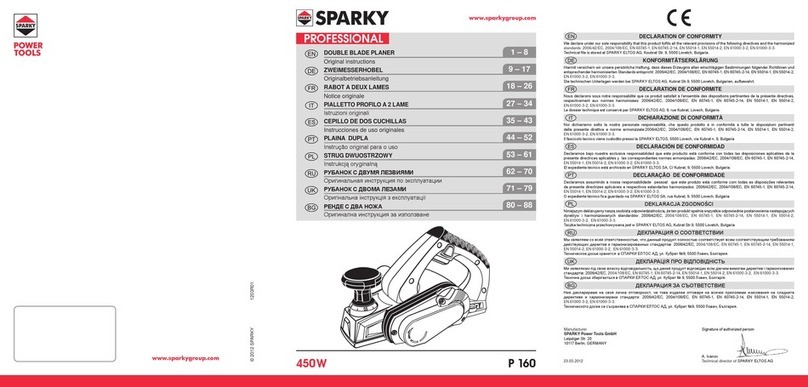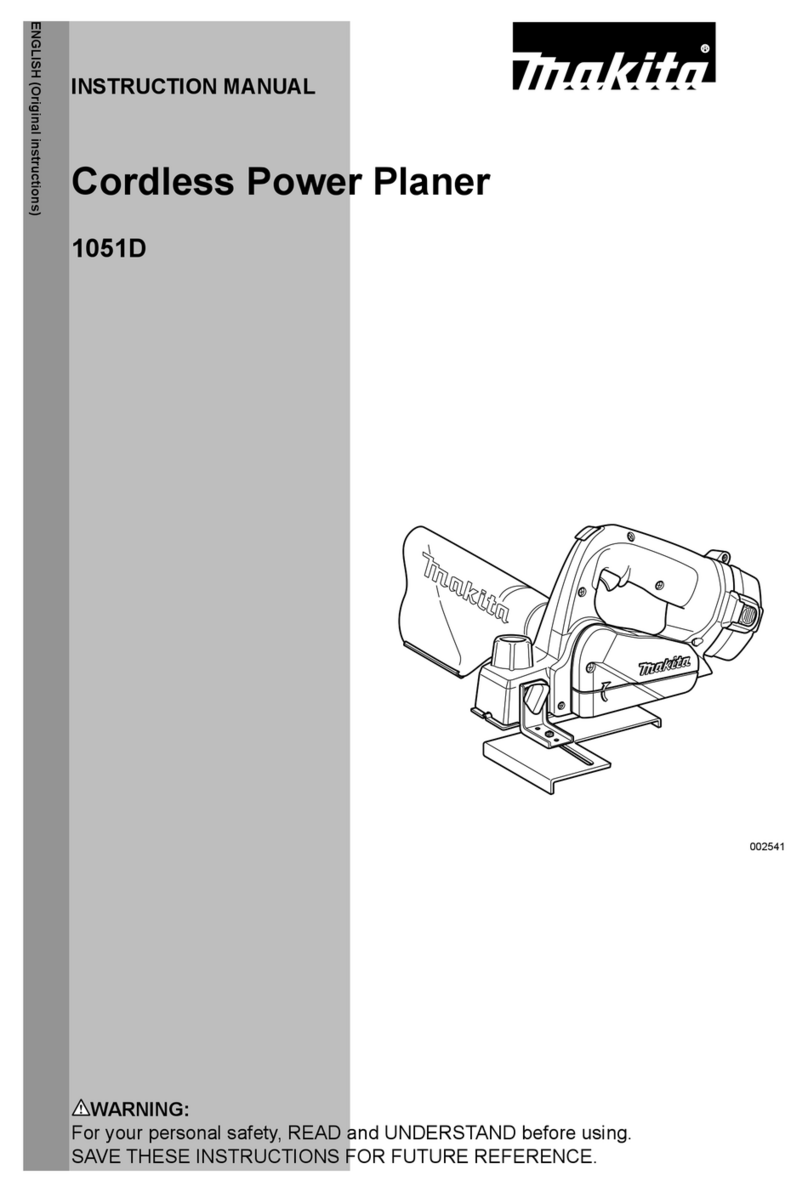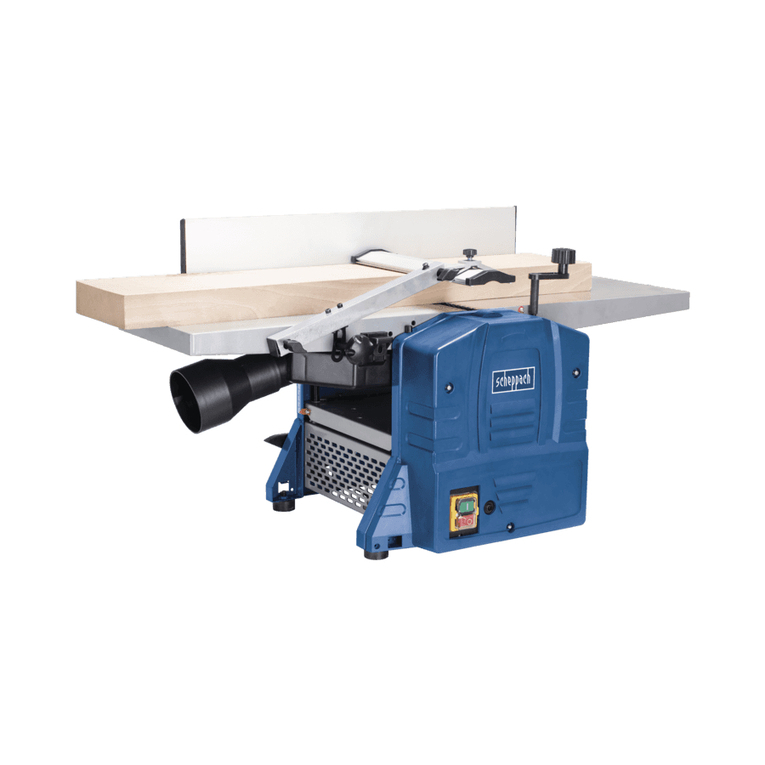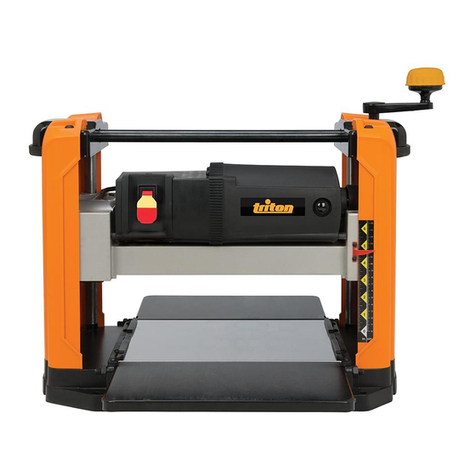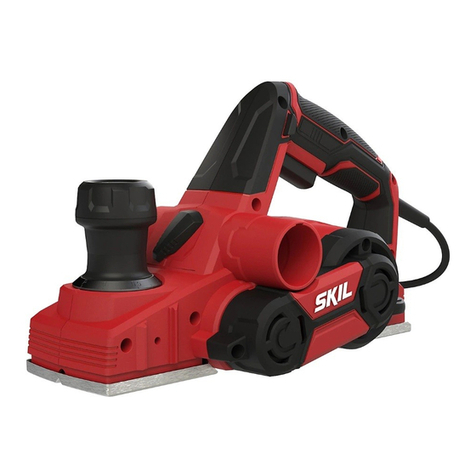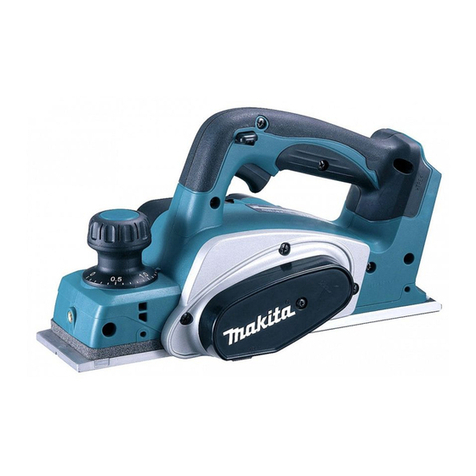Hercules HE091 Assembly instructions

12 1/2" Portable Thickness Planer
Model
HE091
Owner’s Manual &
Safety Instructions
22i
WARNING: To prevent serious injury, User must read and
understand Owner’s Manual. SAVE THIS MANUAL.
When unpacking, make sure that the product is intact and
undamaged. If any parts are missing or broken, please call
1-888-866-5797 as soon as possible. Reference 59313.

Page 2 For technical questions, please call 1-888-866-5797. Item 59313
IMPORTANT SAFETY INFORMATION
GENERAL TOOL SAFETY WARNINGS
Read all safety warnings and all instructions.
Failure to follow the warnings and instructions may result
in electric shock, fire and/or serious injury. Save all
warnings and instructions for future reference.
1. KEEP GUARDS IN PLACE and in working order.
2. REMOVE ADJUSTING KEYS AND WRENCHES.
Form habit of checking to see that keys and adjusting
wrenches are removed from tool before turning it on.
3. KEEP WORK AREA CLEAN.
Cluttered areas and benches invite accidents.
4. DON’T USE IN DANGEROUS ENVIRONMENT.
Don’t use power tools in damp or wet locations,
or expose them to rain. Keep work area well lighted.
5. KEEP CHILDREN AWAY. All visitors should
be kept safe distance from work area.
6. MAKE WORKSHOP KID PROOF with padlocks,
master switches, or by removing starter keys.
7. DON’T FORCE TOOL. It will do the job better
and safer at the rate for which it was designed.
8. USE RIGHT TOOL. Don’t force tool or attachment
to do a job for which it was not designed.
Table A: RECOMMENDED MINIMUM WIRE GAUGE
FOR EXTENSION CORDS
(120 VOLT)
NAMEPLATE
AMPERES
(at full load)
EXTENSION CORD
LENGTH
25′ 50′ 100′ 150′
0 – 6 18 16 16 14
6.1 – 10 18 16 14 12
10.1 – 12 16 16 14 12
12.1 – 16 14 12 Do not use.
9. USE PROPER EXTENSION CORD. Make sure your
extension cord is in good condition. When using
an extension cord, be sure to use one heavy
enough to carry the current your product will draw.
An undersized cord will cause a drop in line voltage
resulting in loss of power and overheating.
Table A shows the correct size to use depending
on cord length and nameplate ampere rating.
If in doubt, use the next heavier gauge.
The smaller the gauge number, the heavier the cord.
10. WEAR PROPER APPAREL. Do not wear
loose clothing, neckties, rings, bracelets, or
other jewelry which may get caught in moving
parts. Nonslip footwear is recommended.
Wear protective hair covering to contain long hair.
11. ALWAYS USE SAFETY GLASSES. Also use
face or dust mask if cutting operation is dusty.
Everyday eyeglasses only have impact resistant
lenses, they are NOT safety glasses.
12. SECURE WORK. Use clamps or a vise to
hold work when practical. It’s safer than using your
hand and it frees both hands to operate tool.
13. DON’T OVERREACH.
Keep proper footing and balance at all times.
14. MAINTAIN TOOLS WITH CARE. Keep tools sharp
and clean for best and safest performance. Follow
instructions for lubricating and changing accessories.
15. DISCONNECT TOOLS before servicing;
when changing accessories, such as
blades, bits, cutters, and the like.
16. REDUCE THE RISK OF UNINTENTIONAL
STARTING. Make sure switch is in
off position before plugging in.
17. USE RECOMMENDED ACCESSORIES.
Consult the owner’s manual for recommended
accessories. The use of improper accessories
may cause risk of injury to persons.
18. NEVER STAND ON TOOL.
Serious injury could occur if the tool is tipped or
if the cutting tool is unintentionally contacted.
19. CHECK DAMAGED PARTS. Before further use
of the tool, a guard or other part that is damaged
should be carefully checked to determine that
it will operate properly and perform its intended
function – check for alignment of moving parts,
binding of moving parts, breakage of parts,
mounting, and any other conditions that may
affect its operation. A guard or other part that is
damaged should be properly repaired or replaced.
20. DIRECTION OF FEED.
Feed work into a blade or cutter against the
direction of rotation of the blade or cutter only.
21. NEVER LEAVE TOOL RUNNING
UNATTENDED. TURN POWER OFF.

Page 3For technical questions, please call 1-888-866-5797.Item 59313
Grounding
TO PREVENT ELECTRIC SHOCK AND
DEATH FROM INCORRECT
GROUNDING WIRE CONNECTION READ AND
FOLLOW THESE INSTRUCTIONS:
110-120 VAC
1. In the event of a malfunction or breakdown,
grounding provides a path of least resistance for
electric current to reduce the risk of electric shock.
This tool is equipped with an electric cord having an
equipment-grounding conductor and a grounding
plug. The plug must be plugged into a matching
outlet that is properly installed and grounded in
accordance with all local codes and ordinances.
2. Do not modify the plug provided – if it will
not fit the outlet, have the proper outlet
installed by a qualified electrician.
3. Improper connection of the equipment-grounding
conductor can result in a risk of electric shock.
The conductor with insulation having an outer
surface that is green with or without yellow
stripes is the equipment-grounding conductor.
If repair or replacement of the electric cord or
plug is necessary, do not connect the equipment-
grounding conductor to a live terminal.
4. Check with a qualified electrician or service
personnel if the grounding instructions are
not completely understood, or if in doubt as
to whether the tool is properly grounded.
5. Use only 3-wire extension cords that
have 3-prong grounding plugs and 3-pole
receptacles that accept the tool’s plug.
6. Repair or replace damaged or worn cord immediately.
Grounding
Pin
125 VAC 3-Prong Plug and Outlet
(for up to 125 VAC and up to 15 A)
7. This tool is intended for use on a circuit that has
an outlet that looks like the one illustrated above in
125 VAC 3-Prong Plug and Outlet. The tool has
a grounding plug that looks like the plug illustrated
above in 125 VAC 3-Prong Plug and Outlet.
8. The outlet must be properly installed and grounded
in accordance with all codes and ordinances.
9. Do not use an adapter to connect
this tool to a different outlet.
Vibration Safety
This tool vibrates during use. Repeated or long-term
exposure to vibration may cause temporary or permanent
physical injury, particularly to the hands, arms and
shoulders. To reduce the risk of vibration-related injury:
1. Anyone using vibrating tools regularly or for an
extended period should first be examined by a
doctor and then have regular medical check-ups
to ensure medical problems are not being caused
or worsened from use. Pregnant women or
people who have impaired blood circulation to
the hand, past hand injuries, nervous system
disorders, diabetes, or Raynaud’s Disease should
not use this tool. If you feel any medical or
physical symptoms related to vibration (such as
tingling, numbness, and white or blue fingers),
seek medical advice as soon as possible.
2. Do not smoke during use. Nicotine reduces
the blood supply to the hands and fingers,
increasing the risk of vibration-related injury.
3. Use tools with the lowest vibration when there
is a choice between different processes.
4. Include vibration-free periods each day of work.
5. Let the tool do the work.
6. To reduce vibration, maintain the tool as
explained in this manual. If any abnormal
vibration occurs, stop use immediately.

Page 4 For technical questions, please call 1-888-866-5797. Item 59313
Planer Safety Warnings
For Your Own Safety Read Instruction
Manual Before Operating
1. Remove all foreign objects, such as nails or metal
fragments, from the workpiece before planing.
2. Do not use to plane non-wood materials.
3. Do not plane workpieces shorter than 15″, narrower
than 3/4″, wider than 12-1/2″ or less than 1/8″ thick.
4. Blades are very sharp and are double-edged!
Wear heavy-duty leather work gloves at all times
when replacing, adjusting, or handling a blade.
5. Change all 3 knives at once. Changing knives
individually could result in imbalance.
6. Do not unclog dust chute with
tool plugged in or blades moving.
Do not insert your finger into the dust chute.
7. Connect dust chute to bag or dust collection system
(not included) before use. Do not use without
a dust bag or dust collection system.
8. DO NOT OPERATE WITH ANY GUARD DISABLED,
DAMAGED, OR REMOVED. Moving guards
must move freely and close instantly.
9. The use of accessories or attachments not
recommended by the manufacturer may
result in a risk of injury to persons.
10. When servicing use only identical replacement parts.
11. Only use safety equipment that has been approved
by an appropriate standards agency. Unapproved
safety equipment may not provide adequate
protection. Eye protection must be ANSI-approved
and breathing protection must be NIOSH-approved
for the specific hazards in the work area.
12. Stay alert, watch what you are doing and use
common sense when operating a power tool. Do
not use a power tool while you are tired or under
the influence of drugs, alcohol or medication.
A moment of inattention while operating power
tools may result in serious personal injury.
13. Industrial applications must follow OSHA guidelines.
14. Maintain labels and nameplates on
the tool. These carry important safety
information. If unreadable or missing, contact
Harbor Freight Tools for a replacement.
15. Avoid unintentional starting. Prepare to
begin work before turning on the tool.
16. People with pacemakers should consult their
physician(s) before use. Electromagnetic fields in
close proximity to heart pacemaker could cause
pacemaker interference or pacemaker failure.
17. The warnings, precautions, and instructions
discussed in this instruction manual cannot
cover all possible conditions and situations
that may occur. It must be understood by the
operator that common sense and caution are
factors which cannot be built into this product,
but must be supplied by the operator.
Warning Symbols and Definitions
This is the safety alert symbol. It is used to
alert you to potential personal injury hazards.
Obey all safety messages that follow this symbol to
avoid possible injury or death.
Indicates a hazardous
situation which, if not
avoided, will result in death or serious injury.
Indicates a hazardous
situation which, if not
avoided, could result in death or serious injury.
Indicates a hazardous
situation which, if not
avoided, could result in minor or moderate injury.
Addresses practices not
related to personal injury.

Page 5For technical questions, please call 1-888-866-5797.Item 59313
Symbology
VVolts
~Alternating Current
AAmperes
n0xxxx/min. No Load Revolutions per Minute (RPM)
WARNING marking concerning Risk
of Eye Injury. Wear ANSI-approved
safety goggles with side shields.
Read the manual before
set-up and/or use.
Keep hands clear of fence area.
WARNING marking
concerning Risk of Fire.
Do not cover ventilation ducts.
WARNING marking concerning
Risk of Electric Shock.
Specifications
Electrical Rating 120VAC / 60Hz / 15A
Motor Speed 21000 RPM
Maximum Cutting Depth 1/8" for 3″ wide or less
3/64" for 12″ wide
Maximum Cutting Width 12-1/2"
Maximum Stock Thickness 6"
Dust Port Diameter 4" and 2-1/2"
Functional Description
Power
Switch
Infeed
Table
Outfeed
Table
Depth
Adjustment
Handle
Dust
Chute
Depth
Adjustment
Scale
Carrying
Handle
Carrying
Handle
Cutterhead
(not visible)
Depth
Gage
Head Lock
Handle
Turret
Depth Stop

Page 6 For technical questions, please call 1-888-866-5797. Item 59313
OPERATION
Read the ENTIRE IMPORTANT SAFETY INFORMATION section at the beginning of this manual
including all text under
subheadings therein before set up or use of
this product.
Tool Set Up
TO PREVENT SERIOUS INJURY FROM
ACCIDENTAL OPERATION:
Turn the Power Switch of the tool off and unplug the
tool from its electrical outlet before performing any
procedure in this section.
Note: For additional information regarding the
parts listed in the following pages, refer to the
Assembly Diagram near the end of this manual.
Assembly/Mounting
CAUTION! Attach Planer securely to solid and level
surface that can support weight of Planer and workpiece,
with enough clearance for movement of workpiece.
Note: Verify that mounting surface has no hidden
components before drilling or driving bolts.
1. Use base to mark mounting holes
on mounting surface.
2. Mount base to mounting surface using
appropriate hardware (sold separately).
Installing Dust Chute
1. Loosen the screws on the Blade Guard sides.
2. Attach Dust Chute to Blade Guard,
lining up the screw holes.
3. Place Washer on ends of each Knob
Screw and finger tighten to secure.
4. Tighten Blade Guard Screws.
Knob Screw
and Washer
Dust Chute
Blade
Guard

Page 7For technical questions, please call 1-888-866-5797.Item 59313
Leveling Table Extensions
1. Place a level (sold separately) across Planer Table and Infeed Table, then check level.
Level
Infeed Table
Outfeed Table Planer Table
2. Loosen Lock Nuts.
3. Adjust as needed by lifting Infeed Table and adjusting Leveling Bolts beneath it.
4. Repeat with Outfeed Table.
5. Tighten Lock Nuts.
Infeed Table
Leveling Bolts
(on left and right)
Lock Nut
(on left and right)
Workpiece and Work Area Set Up
1. Designate a work area that is clean and well-lit.
The work area must not allow access by children
or pets to prevent distraction and injury.
2. Route the power cord along a safe route to reach
the work area without creating a tripping hazard or
exposing the power cord to possible damage.
The power cord must reach the work
area with enough extra length to allow
free movement while working.
3. There must not be objects, such as utility lines,
nearby that will present a hazard while working.

Page 8 For technical questions, please call 1-888-866-5797. Item 59313
General Operation
TO PREVENT SERIOUS INJURY FROM HAZARDS
SUCH AS KICKBACK:
Do not plane workpieces shorter than 15″, narrower
than 3/4″, wider than 12-1/2″, or less than 1/8″ thick.
Use only natural dry woodstock which is free from
nails, staples, knots, etc.
Feed into Planer in line with the grain.
Do not plane wood that is twisted, warped, knotted or
bowed.
Note: If one side of workpiece is uneven, plane with
flat side down first. If both sides are uneven, run one
side through a jointer to flatten it before planing.
Note: Use Depth Adjustment Scale as a reference
to indicate thickness of finished workpiece.
Note: Practice on scrap material until
familiar with Planer′s capabilities.
1. Make sure dust collection system is in place.
2. Make sure Power Switch is in the off-position.
3. Plug in Planer.
Note: Use calipers to measure workpiece.
Note: The Turret Depth Stop dial can be used to
select one of three pre-set depths. Head is lowered to
contact the stop. The depths are marked on the dial.
4. Place workpiece on Planer Table, then turn
Depth Adjustment Handle counterclockwise to
lower Cutterhead until it just touches workpiece.
5. Under the Depth Adjustment Handle; turn
the indicator ring to line up the “ZERO” mark
with the indicator mark on the machine.
Indicator
Mark
6. Push the Head Lock Handle down.
WARNING! To prevent serious injury, do not turn
Planer on with workpiece under Cutterhead.
7. Remove workpiece, then turn Depth
Adjustment Handle counterclockwise.
One full turn will remove 1/16″ of material.
NOTICE: Do not remove more than 1/8″ of material at
one time (1-1/2 turns of Depth Adjustment Handle).
NOTICE: Keep long workpieces level by
supporting them on both ends of Planer
with stands or by other means.
8. The Turret Depth Stop can be set to stop the
Planer at exact thicknesses. i.e. 3/8″, 1/2″, 3/4″.
9. The Depth Gauge offers an alternative method
of setting depth of cut. Slide workpiece
beneath spring-loaded touch pin and lower
the Cutterhead until pin contacts workpiece.
Continue lowering until depth gauge reads
desired depth of cut. Remove workpiece.
10. Turn on Planer by Pressing the green Power Button.
11. After Cutterhead has reached full speed, slowly
guide workpiece into Planer until Infeed Roller takes
control. Workpiece will auto feed through Planer, do
not push on workpiece once it starts autofeeding.
WARNING! To prevent serious injury from kickback,
stand on side nearest the switch and to the side.
WARNING! TO PREVENT SERIOUS INJURY:
Keep hands out from underneath Cutterhead.
12. Retrieve workpiece from Outfeed side.
Note: If using assistant, Rollers may be used to
transport workpiece from Outfeed to Infeed.
Note: If one or both ends of workpiece have a deeper
cut, the problem may be snipe.
See Troubleshooting on page 12for a solution.
Snipe
Figure A: Workpiece
13. Continue to remove material until
desired thickness is achieved.
NOTICE: To prevent damage from clogging,
empty dust collection system frequently.
14. To prevent accidents, turn off tool by pressing
the Paddle Switch, and unplug tool from
its electrical outlet after use. Clean and lubricate
according to Maintenance and Servicing on page
10, then store tool indoors out of children’s reach.

Page 9For technical questions, please call 1-888-866-5797.Item 59313
Installing or Replacing the Blade
1. Turn Planer off and unplug from its electrical outlet.
2. Remove Screws on Blade Guard sides,
and Knob Screws from Dust Chute.
3. Remove Dust Chute and Blade Guard from unit.
Gib
T-Wrench
Blade
Guard
Cuterhead
Release
Switch
CAUTION! Blades are very sharp and are
double-edged! Wear heavy-duty leather work
gloves at all times when handling a blade.
4. Wearing gloves, push the Cutterhead
Release Switch and rotate Cutterhead
toward you until it locks into place.
5. Using included T-Wrench, remove eight
Screws on Gib, then flip wrench over
and use the magnet to remove Gib.
Blade
CAUTION! Change all three Blades
at the same time. Changing Blades
individually could result in imbalance.
6. Using magnet, remove Blade, rotate or
replace, placing holes over Tabs.
7. Replace Gib and eight Screws,
tighten Screws securely.
8. Push Cutterhead Release Switch to allow
rotation to the remaining Blades.
9. Replace Blade Guard and two Screws,
then tighten Dust Chute.

Page 10 For technical questions, please call 1-888-866-5797. Item 59313
MAINTENANCE AND SERVICING
Procedures not specifically explained
in this manual must be performed
only by a qualified technician.
TO PREVENT SERIOUS INJURY FROM
ACCIDENTAL OPERATION:
Turn the Power Switch of the tool off and unplug the
tool from its electrical outlet before performing any
procedure in this section.
TO PREVENT SERIOUS INJURY FROM TOOL
FAILURE:
Do not use damaged equipment.
If abnormal noise or vibration occurs, have
the problem corrected before further use.
Cleaning, Maintenance,
and Lubrication
1. BEFORE EACH USE, inspect the general
condition of the tool. Check for:
• loose hardware,
• misalignment or binding of moving parts,
• cracked or broken parts,
• damaged electrical wiring, and
• any other condition that may
affect its safe operation.
2. PERIODICALLY,wear ANSI-approved safety goggles
and NIOSH-approved breathing protection and blow
dust out of the motor vents using dry compressed air.
3. WARNING! TO PREVENT SERIOUS
INJURY: If the supply cord of this power
tool is damaged, it must be replaced only
by a qualified service technician.
4. After Use:
a. Wear ANSI-approved safety goggles and
NIOSH-approved breathing protection, blow
debris from Planer using dry compressed air.
b. Remove resin residue with pitch and gum remover.
c. Empty dust collection system.
d. Wipe external surfaces with clean cloth.
e. Wax tables.
Internal Maintenance
1. Remove the two Screws on Side Cover.
2. Lift up and tilt bottom out to remove Side Cover.
Side
Cover
Lubrication
3. Elevation Screws and Columns
a. Remove both Side Covers.
b. Clean Elevation Screws and Columns.
c. Lubricate with a light coating of
multipurpose grease (sold separately).
4. Roller Chains
a. Remove left Side Cover.
b. Use chain cleaner (sold separately)
according to manufacturers instructions.
c. Lubricate with chain oil (sold separately),
wipe off excess oil.

Page 11For technical questions, please call 1-888-866-5797.Item 59313
Replacing V-Belt
1. Remove right Side Cover.
2. Move Belt back and forth on pulleys, while pulling
Belt away from pulleys, one groove at a time.
V-belt
3. Put new Belt on upper pulley, then move
Belt back and forth onto lower pulley, while
pushing it onto pulley, one groove at a time.
4. Replace Side Cover.
Correcting Snipe
1. Slightly elevate the infeed and outfeed table ends and
place a sacrificial board at each end of the workpiece.
2. Run the board in at a 15-30° angle. While inserting
the board into the planer, lift both ends up slightly.
3. If snipe can not be avoided, mill the lumber
a few inches longer and leave enough
sacrificial material so that it can be cut out.

Page 12 For technical questions, please call 1-888-866-5797. Item 59313
Troubleshooting
Workpiece
Problem Possible Causes Likely Solutions
Deeper cut at
ends of board
(snipe).
1. Too little support of long boards.
2. Uneven force on cutter head.
1. Provide better support for long boards.
2. Follow instructions according to
Correcting Snipe on page 11.
Torn, ragged,
rough or
raised grain.
1. Blades dull or damaged.
2. Cut is too heavy.
3. Blades cutting against grain.
4. Wood has a high moisture content.
1. Replace blades.
2. Reduce depth of cut.
3. Cut with grain.
4. Use dry wood.
Planer
Problem Possible Causes Likely Solutions
Tool will not start. 1. Cord not connected.
2. No power at outlet.
3. Internal damage or wear. (Carbon
brushes or switch, for example.)
1. Check that cord is plugged in.
2. Check power at outlet. If outlet is unpowered,
turn off tool and check circuit breaker.
If breaker is tripped, make sure circuit is right
capacity for tool and circuit has no other loads.
3. Have qualified technician service tool.
Tool operates
slowly.
Extension cord too long or
wire size too small.
Eliminate use of extension cord. If an extension cord
is needed, use one with the proper diameter for its
length and load. See Table A on page 2.
Performance
decreases
over time.
1. Blades dull or damaged.
2. Carbon brushes worn or damaged.
1. Replace blades.
2. Have qualified technician replace brushes.
Roller case
adjustment
difficult
1. Sprockets and/or chain dirty.
2. Elevating screws and/
or columns dirty.
3. Elevating screws worn.
1. Clean and lubricate sprockets and/or chain.
2. Clean and lubricate elevating
screws and/or columns.
3. Replace elevating screws.
Chain jumping 1. Sprockets worn.
2. Chain worn.
1. Have sprockets replaced.
2. Have chain replaced.
Belt Slipping Loose belt Replace belt.
Excessive
dust in air
Leaking bag or loose connection. Check connections or replace collection bag.
Excessive noise
or rattling.
Internal damage or wear. (Carbon
brushes, bearings, or fan for example.)
Have qualified technician service tool.
Overheating/
Circuit breaker
tripping.
1. Dull blades.
2. Forcing boards through planer.
3. Blade dull or damaged.
4. Cut is too heavy.
5. Motor being strained by long or
small diameter extension cord.
1. Replace blades.
2. Allow auto feed to work at its own rate.
3. Replace blades.
4. Reduce depth of cut.
5. Eliminate use of extension cord.
If an extension cord is needed, use one with
the proper diameter for its length and load.
See Table A on page 2.
Follow all safety precautions whenever diagnosing or servicing the tool.
Disconnect power supply before service.

Page 13For technical questions, please call 1-888-866-5797.Item 59313
PLEASE READ THE FOLLOWING CAREFULLY
THE MANUFACTURER AND/OR DISTRIBUTOR HAS PROVIDED THE PARTS LIST AND ASSEMBLY DIAGRAM
IN THIS MANUAL AS A REFERENCE TOOL ONLY. NEITHER THE MANUFACTURER OR DISTRIBUTOR
MAKES ANY REPRESENTATION OR WARRANTY OF ANY KIND TO THE BUYER THAT HE OR SHE IS
QUALIFIED TO MAKE ANY REPAIRS TO THE PRODUCT, OR THAT HE OR SHE IS QUALIFIED TO REPLACE
ANY PARTS OF THE PRODUCT. IN FACT, THE MANUFACTURER AND/OR DISTRIBUTOR EXPRESSLY
STATES THAT ALL REPAIRS AND PARTS REPLACEMENTS SHOULD BE UNDERTAKEN BY CERTIFIED AND
LICENSED TECHNICIANS, AND NOT BY THE BUYER. THE BUYER ASSUMES ALL RISK AND LIABILITY
ARISING OUT OF HIS OR HER REPAIRS TO THE ORIGINAL PRODUCT OR REPLACEMENT PARTS
THERETO, OR ARISING OUT OF HIS OR HER INSTALLATION OF REPLACEMENT PARTS THERETO.
Record Product’s Serial Number Here:
Note: If product has no serial number, record month and year of purchase instead.
Note: Some parts are listed and shown for illustration purposes only, and are not available
individually as replacement parts. Specify UPC 193175465788 when ordering parts.

Page 14 For technical questions, please call 1-888-866-5797. Item 59313
Parts List
Part Description Qty
1 Base 1
2 Base Board 1
3 Base Side Board 2
4 Screw 4
5 Bearing 2
6 Plate 2
7 Hex Screw 4
8 Hex Screw 4
9 Nut 4
10 Carriage 1
11 C-Ring 1
12 Cutter Head 1
13 Blade 3
14 Blade Plate 3
15 Screw 24
16 Bearing 1
17 Bearing 1
18 C-Ring 1
19 Roller 2
20 Roller Liner 4
21 Washer 4
22 Spring 1
23 Spring 1
24 Spring 2
25 Spring 1
26 Plate 4
27 Screw 8
28 Safety Lock 1
29 Spring 1
30 Platen 1
31 Screw 2
32 Block 2
33 Hex Screw 4
34 Motor Cover 1
35 Brush Seat 2
36 Set Screw 2
37 Stator 1
38 Screw 2
39 Nut 2
40 Nut Seat 2
41 Rotor 1
42 Bearing 2
43 Ring 1
44 Washer 1
45 Gear box (Right) 1
46 Screw 4
47 Brush 2
48 Brush cover 2
49 Liner 2
50 Liner 2
51 1st Gear (Small) 1
52 Double Circle Key 2
53 1st Gear 1
54 Washer 1
55 2nd Gear (Small) 1
56 2nd Gear 1
57 Washer 1
58 Gear box (Left ) 1
59 Bushing 1
60 Output Shaft 1
61 Washer 1
62 Bushing 1
63 C-Ring 1
64 Double Circle Key 2
65 Spur Gear 1
Part Description Qty
66 C-Ring 1
67 Bolt 2
68 Screw 3
69 Power Cord 1
70 Switch box 1
71 Lock 2
72 Screw 1
73 Washer 1
74 Screw 1
75 Washer 1
76 Screw 1
77 Screw 2
78 Driving Wheel 1
79 Overload protector 1
80 Nut 1
81 Connector 1
82 Switch Seat 1
83 Switch 1
84 Paddle 1
85 Pin 1
86 Hex Screw 2
87 Washer 2
88 Screw 2
89 Washer 2
90 Washer 2
91 Belt Wheell 1
92 Nut 1
93 Belt 1
94 Chain Wheel 3
95 Chain 1
96 Plate 1
97 Spring 1
98 Hex Screw 1
99 C-Ring 3
100 Power Cord Clamp 1
101 Screw 2
102 Ring 1
103 Screw 1
104 Washer 1
105 Dust Collector 1
106 Dust Board 1
107 Dust Board 1
108 Screw 3
109 Foam 1
110 Screw 2
111 Washer 2
112 Ring 2
113 Hex Screw 2
114 Nut 2
115 Head Lock Handle 1
116 Plate A 2
117 Plate C 2
118 Spring 2
119 Screw 2
120 Screw 4
121 Nut 2
122 Cover 1
123 Screw 1
124 Hex Screw 1
125 Nut 1
126 T-wrench 1
127 Rod 4
128 Screw Rod (Left) 1
129 Screw Rod (Right) 1
130 Hex Screw 4
Part Description Qty
131 Washer 4
132 Hex Screw 2
133 Washer 2
134 Chain Wheel (Right) 1
135 Screw 1
136 Chain 1
137 Chain Wheel (Left) 1
138 Bushing 1
139 Hex Screw 1
140 Washer 1
141 Washer 1
142 Side Cover (Left) 1
143 Side Cover (Right) 1
144 Screw 4
145 Top Cover 1
146 Chain Seat 1
147 Hex Screw 2
148 Block 1
149 Spring 1
150 Screw 2
151 Carry Handle 2
152 Screw 4
153 Screw 4
154 Handle Boss 1
155 Crank 1
156 Pin 1
157 Elevation Handle 1
158 Screw 1
159 Nut 1
160 Washer 1
161 Elevation Label 1
162 Scale 1
163 Nut 1
164 Hex Screw 1
165 Extension Plate 2
166 Supporter 4
167 Screw 8
168 Screw 4
169 Washer 4
170 Washer 4
171 Nut 4
172 Turntable 1
173 Hex Screw 1
174 Nut 1
175 Spring 1
176 Ball 1
177 Screw 1
178 Height indicator 1
179 Screw 2
180 Indicator Box 1
181 Indicator Pin 1
182 Indicator Spring 1
183 Indicator 1
184 Spacer Ring 1
185 Screw 1
186 Cover 1
187 Depth Gauge Label 1
188 Screw 2
189 Pad 2
190 Dust Tube 1
191 Screw Knob 2
192 Flat Washer 2
193 Scale 1
194 Rotor Outlet Line-Blue 1
195 Rotor Outlet Line-Black 1
196 Overload Protector Wire 1

Page 15For technical questions, please call 1-888-866-5797.Item 59313
Assembly Diagram
47
35
102 103
140
42
41
137
138
115
141
139
119
153
38
118
37
145
146
147
149
158
155
157
159
161
154
162
160
163
156
148
150
151
152
136
134
122
116
117
42
78
121
36
126
32
106
192
111
191
105 190
113
107
109
124
13 64 12 17
93
18 91
92
14
15
125
1611
143
193
90
19
129
20
127
174
177
172
176
175
4
169
170
1
132
3
22
24
2
88
130 131
133
9
168
26
89
5
6
24
8
25
23
21
128
167 166165
142
178
95
180181184186 183
185
187
188
179
189
182 97
96
10
29
98
28
100
30
31
34
58
48
40
77
84
9499
83
82
74
85
70
27
173
144
112
43
45
46
76
67
66
65
63
62
61
64
60
59
49 50
68
49
54
53
51
52
50
56
55
52
108
135
120
7569
71
33
44
80
79
57
73
164
81
86
87
7
39
123
101
72
114
116
171
110
104
196
194
195

26677 Agoura Road • Calabasas, CA 91302 • 1-888-866-5797
Visit our website at: http://www.harborfreight.com
For technical questions, please call 1-888-866-5797
Copyright©2022 by Harbor Freight Tools®. All rights reserved. No portion of this manual or
any artwork contained herein may be reproduced in any shape or form without the express
written consent of Harbor Freight Tools. Diagrams within this manual may not be drawn
proportionally. Due to continuing improvements, actual product may differ slightly from the
product described herein. Tools required for assembly and service may not be included.
LIMITED 90 DAYS WARRANTY
Harbor Freight Tools Co. makes every effort to assure that its products meet high quality and durability standards,
and warrants to the original purchaser that this product is free from defects in materials and workmanship for the
period of 90 days from the date of purchase. This warranty does not apply to damage due directly or indirectly,
to misuse, abuse, negligence or accidents, repairs or alterations outside our facilities, criminal activity, improper
installation, normal wear and tear, or to lack of maintenance. We shall in no event be liable for death, injuries
to persons or property, or for incidental, contingent, special or consequential damages arising from the use of
our product. Some states do not allow the exclusion or limitation of incidental or consequential damages, so the
above limitation of exclusion may not apply to you. THIS WARRANTY IS EXPRESSLY IN LIEU OF ALL OTHER
WARRANTIES, EXPRESS OR IMPLIED, INCLUDING THE WARRANTIES OF MERCHANTABILITY AND FITNESS.
To take advantage of this warranty, the product or part must be returned to us with transportation charges
prepaid. Proof of purchase date and an explanation of the complaint must accompany the merchandise.
If our inspection verifies the defect, we will either repair or replace the product at our election or we may
elect to refund the purchase price if we cannot readily and quickly provide you with a replacement. We will
return repaired products at our expense, but if we determine there is no defect, or that the defect resulted
from causes not within the scope of our warranty, then you must bear the cost of returning the product.
This warranty gives you specific legal rights and you may also have other rights which vary from state to state.
Table of contents
